Mastering Animation Timing: Essential Techniques for Dynamic Presentation Slides
Understanding Animation Timing Fundamentals
Animation timing can make or break your presentation. When done right, it guides your audience through your content with precision and purpose. When done poorly, it becomes a distraction. Let's dive into the art and science of perfecting your slide animations for maximum impact.
Understanding Animation Timing Fundamentals
Animation timing isn't just about how fast or slow elements move on your slides—it's about creating a rhythm that supports your message and guides your audience's attention. I've found that understanding the psychology behind effective timing is crucial for creating presentations that truly resonate.
Core Timing Parameters
- Duration: How long an animation takes to complete
- Delay: Time before an animation begins
- Speed curves: How animation accelerates and decelerates
- Sequencing: Order and relationship between multiple animations

The Psychology of Animation Timing
Our brains process visual information in specific ways. Well-timed animations work with these natural cognitive processes rather than against them. For instance, animations that are too fast can cause cognitive overload, while those that are too slow can lead to disengagement.
The relationship between animation speed and audience comprehension follows a clear pattern:
Common Timing Mistakes to Avoid
The 5-Second Rule:
If your audience is still watching your animation instead of focusing on your content after 5 seconds, your animation is likely too complex or poorly timed.
- Animations that are too fast and jarring, causing audience disorientation
- Excessive delays between related animations, breaking the logical flow
- Inconsistent timing patterns across similar elements, creating visual discord
- Overlapping animations that compete for attention rather than guide it
- Animations that continue long after their informational value has been delivered
Visual Hierarchy Through Timing
Properly timed animations create a natural hierarchy that guides your audience through complex information:
flowchart TD
A[Audience Attention] --> B[Primary Element]
B -->|Short Delay| C[Supporting Element 1]
B -->|Medium Delay| D[Supporting Element 2]
C -->|Brief Pause| E[Detail Point 1]
C -->|Brief Pause| F[Detail Point 2]
D -->|Brief Pause| G[Detail Point 3]
D -->|Brief Pause| H[Detail Point 4]
style B fill:#FF8000,stroke:#FF8000,color:white
style C fill:#FF9933,stroke:#FF9933,color:white
style D fill:#FF9933,stroke:#FF9933,color:white
style E fill:#FFCC99,stroke:#FFCC99
style F fill:#FFCC99,stroke:#FFCC99
style G fill:#FFCC99,stroke:#FFCC99
style H fill:#FFCC99,stroke:#FFCC99
Essential Animation Timing Techniques for Beginners
When I first started working with presentation animations, I quickly learned that mastering a few fundamental timing techniques could dramatically improve the quality of my slides. Let's explore these essential techniques that will help you create more engaging and effective presentations.
Entrance and Exit Animation Basics
The way elements enter and exit your slides sets the tone for your entire presentation. Professional slides use entrance and exit animations strategically to maintain audience focus.
Entrance Timing Best Practices
- Keep entrance durations between 0.5-1.5 seconds
- Use shorter durations for smaller elements
- Sequence related items with 0.2-0.3 second delays
- Ensure text is readable within 1 second of appearance
Exit Timing Best Practices
- Exit animations should be slightly faster than entrances
- Use 0.3-0.7 second durations for most exits
- Group related exits to occur simultaneously
- Consider whether exits should precede or overlap new entrances
The "Build" Technique
The build technique is one of the most effective ways to present complex information. Instead of overwhelming your audience with everything at once, you reveal information in digestible chunks with precise timing.

The build technique in action: Elements appear in a logical sequence with appropriate timing between each reveal.
Build Technique Timing Formula:
- First element: 0.7-1.0 second entrance
- Pause: 1.5-2.0 seconds (to allow processing)
- Related elements: 0.5-0.7 second entrances with 0.2-0.3 second delays between each
- Final emphasis element: Slightly slower entrance (0.8-1.0 seconds) with distinctive animation
Creating Consistent Animation Rhythm
A consistent animation rhythm helps your audience know what to expect, allowing them to focus on your content rather than being distracted by unpredictable timing.
Animation rhythm patterns for different presentation styles:
Smooth Transitions Between Slides
The timing of transitions between slides is just as important as the timing of animations within slides. Smooth transitions maintain the flow of your presentation and prevent jarring interruptions.
Effective transition timing sequence:
sequenceDiagram
participant S1 as Slide 1
participant T as Transition
participant S2 as Slide 2
Note over S1: Complete key points
S1->>T: Exit animations (0.5s)
Note over T: Brief pause (0.2s)
T->>S2: Slide transition effect (0.7s)
Note over S2: Brief pause (0.3s)
S2->>S2: Entrance animations begin
Platform-Specific Animation Timing Controls
Different presentation platforms offer varying levels of animation timing control. Understanding the specific capabilities and limitations of your chosen platform is essential for creating precisely timed animations.
PowerPoint Animation Timing
Microsoft PowerPoint offers some of the most robust animation timing controls available in presentation software. I've found that mastering PowerPoint's Animation Pane is key to creating sophisticated timing sequences.
PowerPoint Animation Pane
PowerPoint's Animation Pane allows you to precisely control the timing of each animated element. You can add animations to PowerPoint with exact timing specifications including:
- Start timing options: On Click, With Previous, After Previous
- Duration in seconds or milliseconds
- Delay before animation begins
- Reorder animations by dragging in the Animation Pane
- Group multiple animations to synchronize timing
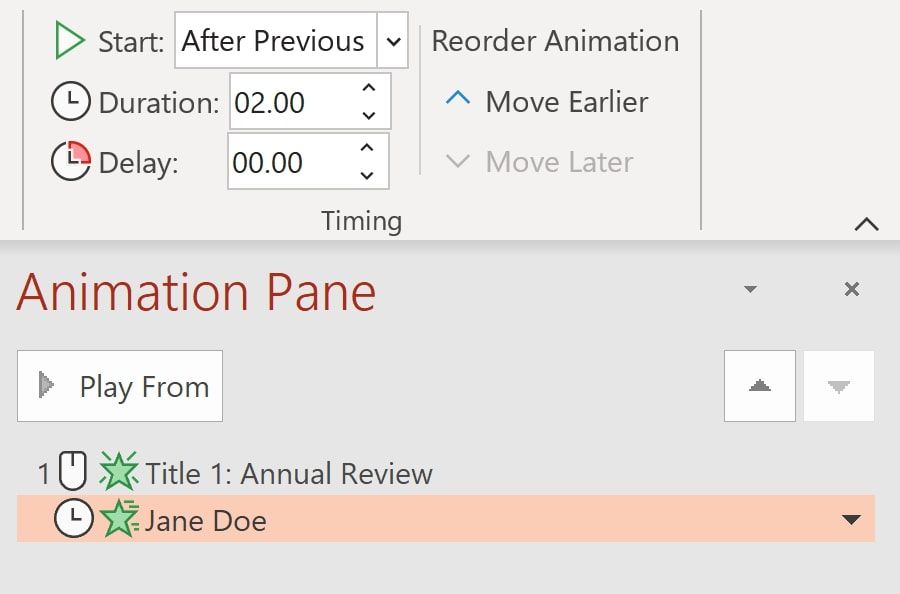
Advanced PowerPoint Timing Triggers
PowerPoint allows you to create sophisticated timing relationships using triggers:
flowchart TD
A[Click Trigger] -->|Initiates| B[Primary Animation]
B -->|Automatically After 0.5s| C[Secondary Animation]
B -->|Automatically After 1.2s| D[Tertiary Animation]
C -->|On Hover Trigger| E[Detail Animation 1]
D -->|On Click Trigger| F[Detail Animation 2]
style A fill:#FF8000,stroke:#FF8000,color:white
style B fill:#FF9933,stroke:#FF9933,color:white
style C fill:#FFCC99,stroke:#FFCC99
style D fill:#FFCC99,stroke:#FFCC99
Pro Tip: Custom Animation Paths
For ultimate timing control, combine custom motion paths with duration adjustments. Create motion paths with varying speeds by adjusting the "smooth start" and "smooth end" options in the Effect Options dialog.
Google Slides Animation Timing
While Google Slides offers fewer timing controls than PowerPoint, you can still achieve excellent results with some creative approaches.
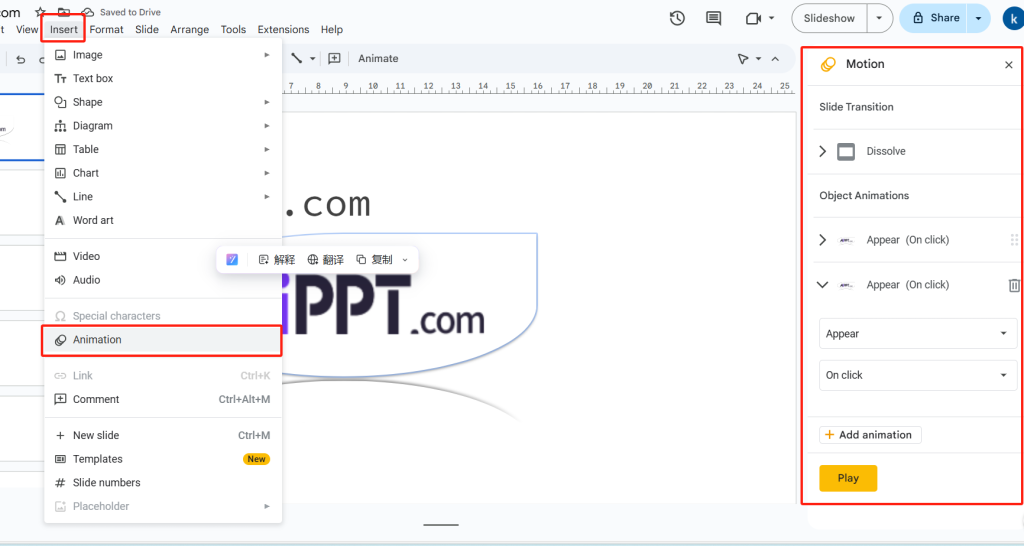
Google Slides Timing Options
Google Slides offers three primary timing options:
- On click: Animation occurs when you click during presentation
- After previous: Animation occurs automatically after the previous animation
- With previous: Animation occurs simultaneously with the previous animation
While Google Slides doesn't offer precise duration controls, you can add animations to Google Slides with relative speed settings: Slow, Medium, or Fast.
Creative Workarounds for Google Slides Timing Limitations
Despite its limitations, you can achieve sophisticated timing effects in Google Slides with these Google Slides tricks:
The "Multiple Object" Technique
Create copies of objects at different stages of an animation sequence, then use a series of entrance and exit animations to create the illusion of more complex timing control.
The "Staged Reveal" Technique
Use transparent shapes to cover portions of your content, then animate them to disappear in sequence, creating a timed reveal effect.
The "Slide Within a Slide" Technique
Insert a portion of another slide as an image, then animate it to create the effect of synchronized animations that would be difficult to achieve with standard Google Slides timing controls.
Platform Comparison: Animation Timing Capabilities
| Feature | PowerPoint | Google Slides |
|---|---|---|
| Precise Duration Control | ✓ (millisecond precision) | ✗ (only Slow/Medium/Fast) |
| Delay Timing | ✓ (millisecond precision) | ✗ (not available) |
| Animation Sequencing | ✓ (extensive options) | ✓ (basic options) |
| Trigger-Based Animations | ✓ (click, hover, bookmark) | ✓ (click only) |
| Animation Reordering | ✓ (drag and drop) | ✓ (limited control) |
| Speed Curve Control | ✓ (smooth start/end) | ✗ (not available) |
| Animation Timeline View | ✓ (detailed) | ✗ (list view only) |
Advanced Animation Timing Strategies for Visual Storytelling
Beyond the basics, animation timing can be a powerful storytelling tool. I've discovered that strategically timed animations can create emotional responses, build anticipation, and emphasize key points in ways that static content simply cannot.
The "Reveal and Emphasize" Technique
This advanced technique uses a two-stage timing approach to first reveal content and then draw attention to the most important elements.
Implementation Steps
- Initial reveal of all content (0.7-1.0 seconds)
- Brief pause for audience scanning (1.5-2.0 seconds)
- Subtle dimming of secondary elements (0.5 seconds)
- Emphasis animation on key element - scale, glow, or color change (0.7 seconds)
- Hold emphasis state while discussing the key point
- Restore all elements to equal prominence when moving on
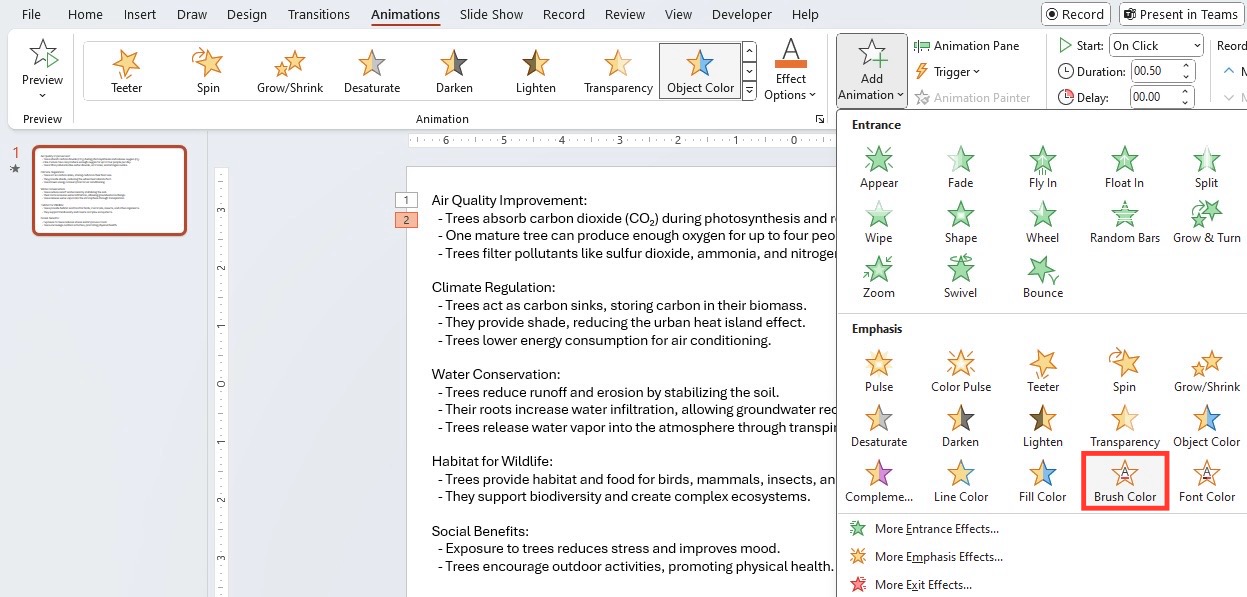
Creating Tension and Resolution
Timing can be used to create emotional responses that enhance your message. One powerful approach is to build tension through timing, then provide resolution.
The tension and resolution timing pattern:
flowchart LR
A[Problem Statement] -->|Slow Reveal
1.5-2.0s| B[Challenge Visualization]
B -->|Increasing Speed
Series of Quick
0.3-0.5s Animations| C[Peak Tension]
C -->|Deliberate Pause
1.5-2.0s| D[Solution Reveal]
D -->|Smooth, Relaxed
1.0-1.2s Animation| E[Resolution State]
style C fill:#FF8000,stroke:#FF8000,color:white
style E fill:#66BB6A,stroke:#66BB6A,color:white
This timing pattern works particularly well for:
- Problem-solution scenarios
- Before-and-after comparisons
- Revealing surprising data or insights
- Demonstrating transformation processes
Synchronizing Animations with Speaking Points
One of the most powerful timing techniques is to precisely synchronize your animations with your verbal presentation. This creates a seamless integration between what you're saying and what your audience is seeing.
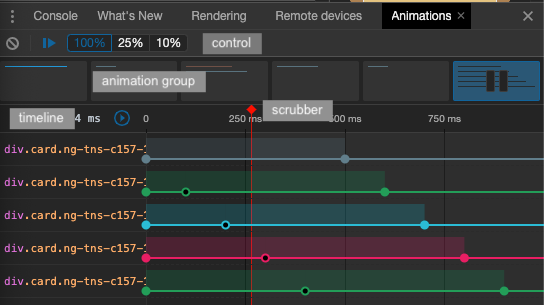
Speaker-Animation Synchronization Tips:
- Use "On Click" animations for key points you want to emphasize verbally
- Practice your timing to create a natural rhythm between your words and animations
- Include brief pauses in your script to allow animations to complete
- For complex sequences, use automatic timing (After Previous) for related animations once triggered
- Add presenter notes with animation cues to help you remember timing during delivery
Using PageOn.ai's AI Blocks for Complex Timing Sequences
Creating complex animation timing sequences traditionally requires significant technical expertise. PageOn.ai's AI Blocks feature simplifies this process by allowing you to visualize and implement sophisticated timing patterns without deep technical knowledge.
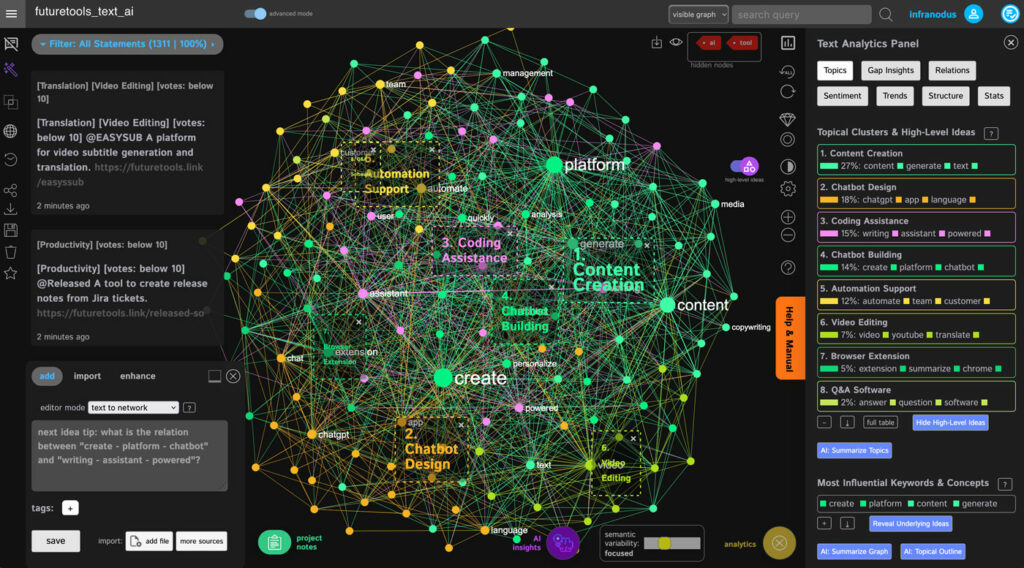
How AI Blocks Simplifies Complex Timing
- Visual Timeline: Drag and drop interface for precise timing control
- Timing Templates: Pre-built timing sequences optimized for different content types
- Smart Synchronization: AI-powered suggestions for optimal timing between related elements
- Real-time Preview: Immediately see how your timing choices affect the animation flow
- Cross-platform Export: Apply your timing sequences to both PowerPoint and Google Slides
Data-Driven Animation Timing for Impactful Presentations
When presenting data, animation timing becomes particularly crucial. Well-timed data animations can transform complex information into clear, digestible insights. I've found that strategic timing helps audiences grasp relationships between numbers and understand trends more intuitively.
Chart and Graph Animation Timing
Different types of charts benefit from different animation timing approaches:
Optimal animation durations by chart type:
Bar/Column Chart Timing
- Animate bars sequentially (0.1-0.2s delay between each)
- Use consistent grow direction (bottom-up or left-right)
- Total animation sequence: 1.0-2.5s depending on number of bars
- Add labels only after bars reach final height/width
Line Chart Timing
- Draw line progressively (1.2-1.8s total duration)
- Add data points after line completes (0.3-0.5s delay)
- For multiple lines, stagger starts by 0.5-0.7s
- Highlight trend areas after all lines complete
Pie/Donut Chart Timing
- Draw segments in clockwise sequence (1.5-2.0s total)
- Sequence from largest to smallest segment
- Add labels as each segment completes
- Optional: Explode key segment after full chart appears (0.5s)
Scatter/Bubble Chart Timing
- Reveal grid/axes first (0.5s)
- Animate points in groups by category (0.7-1.0s per group)
- Use brief pause between groups (0.2-0.3s)
- Add trendlines after all points appear (0.7s)
Timed Reveals for Complex Data
Complex data presentations benefit from breaking information into digestible chunks with strategic timing.
Data complexity determines optimal reveal sequence:
flowchart TD
A[Start with Framework] -->|0.7s| B[Add Context Elements]
B -->|1.0s| C[Present Primary Data]
C -->|1.5s| D{Data Complexity}
D -->|Simple
0.5s| E[Show All Supporting Data]
D -->|Complex
0.8s| F[Show First Data Category]
F -->|2.0s| G[Show Second Data Category]
G -->|2.0s| H[Continue Sequential Reveals]
E -->|2.0s| I[Highlight Key Insights]
H -->|1.5s| I
style A fill:#FFCC99,stroke:#FFCC99
style C fill:#FF9933,stroke:#FF9933,color:white
style I fill:#FF8000,stroke:#FF8000,color:white
The "Data Storytelling" Timing Formula:
- Context setting: 1.0-1.5s to establish the data framework
- Primary data reveal: 1.0-1.2s to show the main metrics
- Audience processing time: 2.0-3.0s pause for mental processing
- Supporting data: 0.7-1.0s per related data point or category
- Insight highlight: 1.0-1.2s to emphasize the key takeaway
Cause-and-Effect Animation Timing
When showing relationships between data elements, timing can be used to visually demonstrate cause and effect.
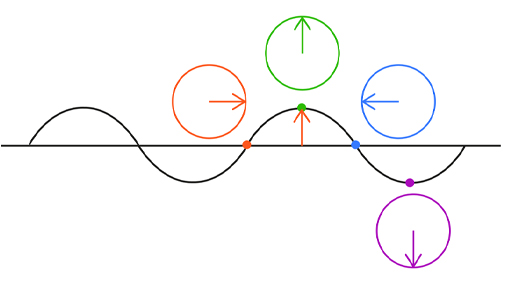
For effective cause-and-effect animations:
- Animate the cause element first (0.7-1.0s)
- Add a brief pause (0.3-0.5s) to create anticipation
- Animate the connecting element (arrow, line) next (0.5-0.7s)
- Animate the effect element last (0.7-1.0s)
- Use consistent color themes to reinforce the relationship
PageOn.ai's Deep Search for Data Visualization
PageOn.ai's Deep Search feature can automatically identify cause-and-effect relationships in your data and suggest optimal timing sequences for animations that highlight these connections. This AI-powered approach ensures your data tells a coherent story without requiring you to manually program complex animation sequences.
Optimizing Animation Timing for Different Presentation Contexts
I've learned through experience that the same animation timing that works perfectly in one context might fail in another. Different presentation environments demand different timing approaches to maximize impact and clarity.
In-Person vs. Virtual Presentation Timing
Timing adjustment recommendations by presentation context:
In-Person Timing Considerations
- Faster animations (0.5-0.8s) maintain energy in the room
- Shorter delays between elements (0.2-0.3s)
- More "On Click" animations for presenter control
- Quicker transitions between slides (0.5-0.7s)
- Allow for audience reaction time after key points
Virtual Timing Considerations
- Slower animations (0.8-1.2s) to account for potential lag
- Longer delays between elements (0.4-0.6s)
- More automatic timing sequences for smooth delivery
- Longer pauses after complex information (2.5-3.5s)
- Clearer visual cues to compensate for reduced presenter presence
Self-Running vs. Presenter-Led Timing
The timing needs for self-running presentations differ significantly from those that will be guided by a presenter.
Timing comparison between presentation types:
flowchart TD
A[Presentation Type] --> B[Presenter-Led]
A --> C[Self-Running]
B --> D[Click-Based Timing]
B --> E[Variable Pacing]
B --> F[Emphasis Animations]
C --> G[Automatic Timing]
C --> H[Consistent Pacing]
C --> I[Self-Explanatory Animations]
D --> J[On Click: 70-80% of animations]
E --> K[Adaptable to audience reactions]
F --> L[Triggered at key speaking points]
G --> M[After Previous: 90-95% of animations]
H --> N[Consistent 2-4s viewing time per point]
I --> O[Complete visual sequences without narration]
style B fill:#FF9933,stroke:#FF9933
style C fill:#42A5F5,stroke:#42A5F5
Self-Running Presentation Timing Formula:
- Title/main point: 2.0-3.0s static display before animations begin
- Content build animations: 0.7-1.0s per element
- Reading time: 1.5-2.0s per 20 words of text
- Diagram/chart comprehension: 3.0-5.0s depending on complexity
- Transition to next slide: Begin after full content viewing time plus 2.0-3.0s
Audience-Specific Timing Adjustments
Different audiences have different processing speeds and attention spans. Tailoring your animation timing to your specific audience can significantly improve comprehension and engagement.
| Audience Type | Animation Duration | Delay Between Elements | Processing Time | Animation Style |
|---|---|---|---|---|
| Executive | 0.5-0.7s | 0.2-0.3s | 1.5-2.0s | Subtle, professional |
| Technical | 0.7-1.0s | 0.3-0.4s | 2.0-3.0s | Precise, logical |
| General Public | 0.8-1.2s | 0.4-0.6s | 2.5-3.5s | Engaging, clear |
| Educational | 1.0-1.5s | 0.5-0.7s | 3.0-4.0s | Explanatory, staged |
| Sales/Marketing | 0.6-0.9s | 0.2-0.4s | 1.5-2.5s | Dynamic, impactful |
Cross-Device Testing and Optimization
Animation timing can vary across different devices and screen sizes. Testing and optimizing for various viewing contexts ensures consistent experiences.
Device-Specific Timing Considerations
- Desktop presentations: Standard timing (as designed)
- Mobile devices: Increase durations by 15-20% for smaller screens
- Projectors: Test for visibility of quick animations; may need 10-15% longer durations
- High-resolution displays: Standard timing works well
- Older hardware: May experience lag; consider simpler animations

PageOn.ai's Vibe Creation for Context Optimization
PageOn.ai's Vibe Creation feature helps you quickly establish the right animation timing feel for specific contexts. This tool analyzes your presentation content, target audience, and delivery medium to suggest optimal timing parameters that will create the most effective "vibe" for your specific presentation scenario.
Future-Proofing Your Animation Timing Skills
As presentation technologies evolve, so do animation timing techniques. Staying ahead of emerging trends and developing adaptable skills will ensure your presentations remain effective and engaging.
Emerging Animation Timing Trends

Micro-Interactions
Brief, subtle animations (0.2-0.4s) that respond to user interactions or emphasize small changes are becoming increasingly important. These micro-interactions create a sense of polish and responsiveness without overwhelming the audience.
Variable Speed Animations
Rather than uniform timing throughout an animation, variable speed animations adjust their pace dynamically. They might start slowly, accelerate through the middle, and slow again at the end, creating a more natural and engaging visual experience.
Contextual Timing
Emerging presentation tools are beginning to adjust animation timing based on content context. For example, complex data visualizations automatically receive longer animation durations than simple text reveals.
Audience-Responsive Timing
Future presentation systems may use audience attention metrics (through eye tracking or engagement analytics) to dynamically adjust animation timing for optimal comprehension and engagement.
AI-Powered Animation Timing
Artificial intelligence is revolutionizing how we approach animation timing in presentations. AI slide design tools can now optimize timing parameters automatically based on content analysis.
How AI optimizes animation timing:
flowchart TD
A[Content Analysis] --> B[Content Complexity Assessment]
A --> C[Relationship Identification]
A --> D[Key Point Detection]
B --> E[Timing Parameter Generation]
C --> E
D --> E
E --> F[Animation Sequence Creation]
E --> G[Duration Optimization]
E --> H[Delay Calibration]
F --> I[Final Animation Timeline]
G --> I
H --> I
style A fill:#FF9933,stroke:#FF9933,color:white
style E fill:#FF9933,stroke:#FF9933,color:white
style I fill:#FF8000,stroke:#FF8000,color:white
Benefits of AI-Optimized Timing:
- Content-aware timing adjustments based on complexity and importance
- Automatic sequencing of related elements for logical flow
- Audience-specific timing recommendations
- Consistent timing patterns across presentations
- Time-saving automation of tedious timing adjustments
Developing Your Animation Timing Style Guide
Creating a personal or organizational animation timing style guide ensures consistency across all your presentations.
Key Components of a Timing Style Guide
- Standard duration ranges for different animation types
- Consistent delay patterns between sequential elements
- Timing rules for different content categories (text, images, data)
- Platform-specific timing adjustments
- Audience-specific timing guidelines
- Standard transition timing between slides

Using PageOn.ai's Agentic Capabilities for Advanced Timing
PageOn.ai's Agentic capabilities represent the cutting edge of animation timing technology, allowing you to transform conceptual timing ideas into polished, professional animations.

How PageOn.ai's Agentic Capabilities Work
- Natural Language Instructions: Simply describe the timing effect you want (e.g., "reveal these points one by one with a slight pause between each")
- Content-Aware Timing: The system analyzes your content to determine optimal timing parameters
- Contextual Adaptation: Automatically adjusts timing based on presentation context and audience
- Timing Templates: Access and customize pre-built timing sequences for common scenarios
- Real-Time Adjustment: Fine-tune timing parameters with intuitive controls
Transform Your Visual Expressions with PageOn.ai
Ready to take your presentation animations to the next level? PageOn.ai's intelligent timing tools help you create perfectly timed animations that enhance your message and captivate your audience—without the technical headaches.
Start Creating with PageOn.ai TodayMastering the Art of Animation Timing
Animation timing is truly the invisible force that makes or breaks your presentations. I've found that mastering these techniques has transformed my ability to communicate complex ideas effectively and keep my audience engaged throughout my presentations.
As you apply these techniques to your own presentations, remember that effective timing is both an art and a science. The technical parameters provide a foundation, but your own creative judgment and understanding of your audience will ultimately guide your timing decisions.
With tools like PageOn.ai at your disposal, creating sophisticated animation timing sequences is more accessible than ever. Whether you're a beginner just starting to explore animation or an experienced presenter looking to refine your timing techniques, the strategies we've covered will help you create more dynamic, engaging, and effective presentations.
You Might Also Like
Transform Raw Text Data into Compelling Charts: AI-Powered Data Visualization | PageOn.ai
Discover how AI is revolutionizing data visualization by automatically creating professional charts from raw text data. Learn best practices and real-world applications with PageOn.ai.
Breaking the Ice: Transform Your Opening Minute from Predictable to Powerful
Discover how to transform the first 60 seconds of your presentation from cliché to compelling with visual hooks, interactive strategies, and storytelling techniques using PageOn.ai.
From Status Quo to Solution: Crafting the Perfect Pitch Narrative Arc | PageOn.ai
Learn how to transform your business presentations with powerful status quo to solution narratives. Discover visual storytelling techniques that captivate investors and stakeholders.
Mastering the American Accent: Essential Features for Global Professional Success
Discover key American accent features for global professionals with visual guides to vowel pronunciation, rhythm patterns, and industry-specific applications for career advancement.
